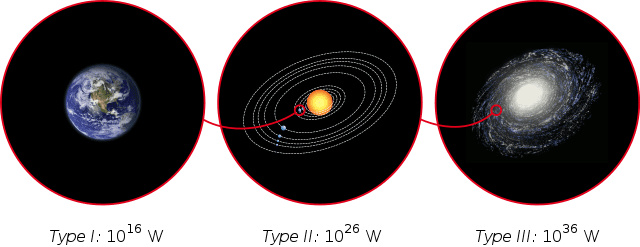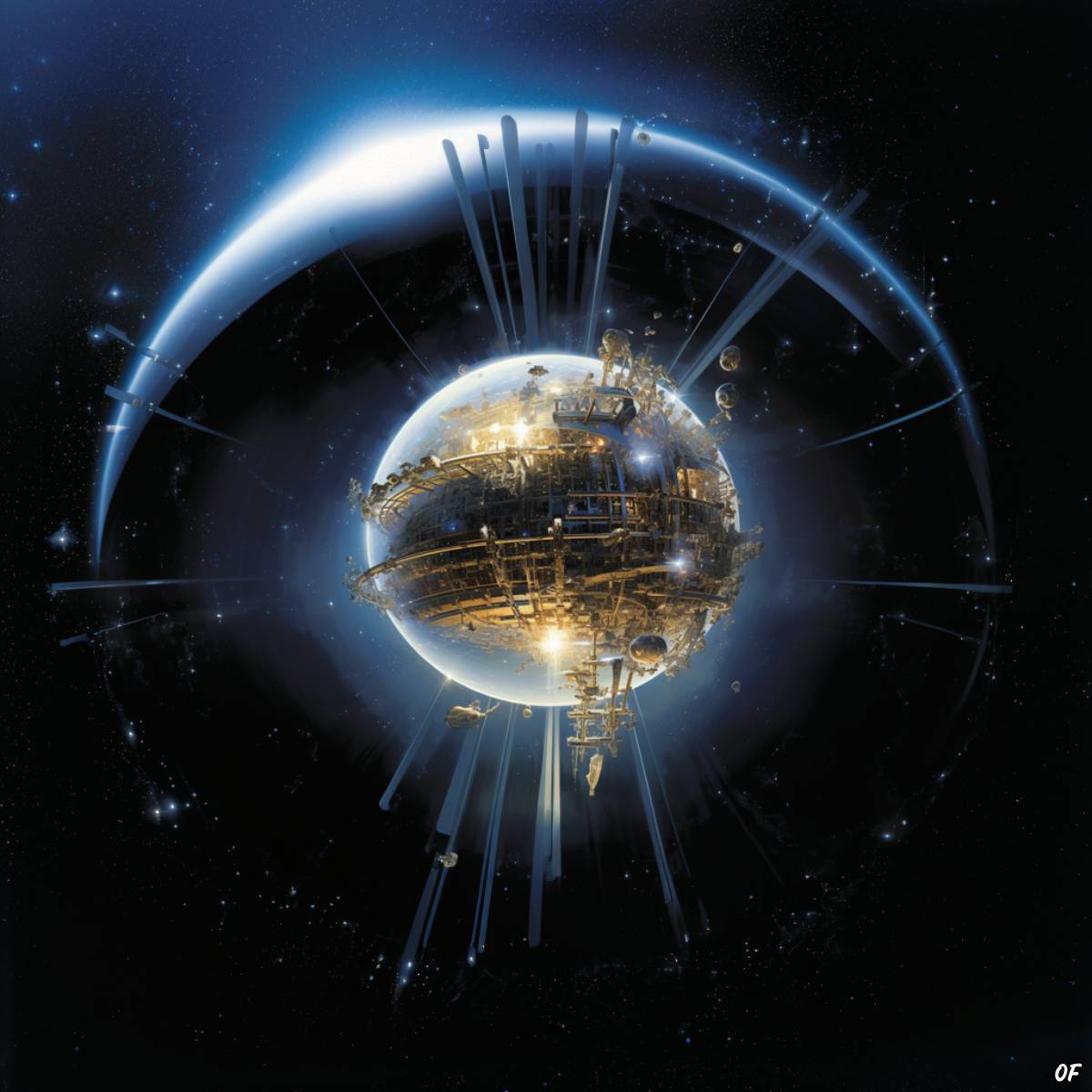The entire world’s current power usage is around 17 x 1012 watts (17 Terawatts). It might sound impressive and is certainly enough to keep all Earth’s lights on for now. But imagine the power we could access and the feats we could achieve if we could harness something closer to the full 3.9 x 1026 watts output of our parent star, the sun.
The Dyson sphere is a conceptual route to capturing a whole star’s worth of energy. It involves building a megastructure around a star, capable of capturing that star’s energy for consumption—a similar idea to installing solar panels on Earth to capture the sun’s energy but on a much larger scale.
With intelligent use of the clean solar energy tapped by a Dyson sphere, we could solve all human energy demands and problems in a stroke. At the same time, we could create a stellar engine that would ratchet up our space exploration ambitions several notches.
Sci-fi dream or reality?
You might have come across Dyson spheres in Star Trek or science fiction books. But did you know that they’re a real—if theoretical—subject of astronomical research and discussion?
Inspired by science fiction concepts such as those in Olaf Stapledon’s classic novel ‘Star Maker,’ the physicist and astronomer Freeman J. Dyson first proposed the idea of solar collection megastructures in a 1960 journal article in Science.

In his paper (“Search for Artificial Stellar Sources of Infrared Radiation“), Dyson imagined the possibility of orbiting solar energy technologies as a thought experiment. If the characteristics of such structures could be determined, they might then help in the broader search for intelligent extraterrestrial life. This advance could become inevitable as a technological civilization evolved, and its growing energy needs outstripped its planetary resources.
Dyson proposed that the most likely habitat for these aliens would be a Dyson sphere-like “dark object” with a surface temperature of 200-300 degrees Kelvin. Dyson wrote that he expected copious infrared radiation to be detectable due to the star at the center of this object.
What would a Dyson sphere look like?
Overall, the Dyson sphere is a fantastic theoretical idea for fueling the energy needs of an advanced civilization that has outgrown its home planet’s resources. But to say that building a Dyson sphere is a challenge is a severe understatement. It’s an engineering challenge, wrapped in layers of a logistical challenge, intertwined with a resourcing challenge.
Dyson sphere ‘shell’
While this type of solid shell enclosure is the Dyson sphere seen most often in fiction, it’s not Dyson’s stated conception. He did not consider a solid spherical structure or ring surrounding a star and described this idea as “mechanically impossible.”
A physical sphere spinning in its orbit around the sun would experience gravity as a centrifugal force, with its rotation causing destructive stress and breakdown. No known material has sufficient tensile strength to preserve the sphere’s integrity under these forces.
Dyson swarm
Instead, Dyson envisaged something better described as a loose collection of a “swarm” of energy-collecting objects, moving on independent orbits around a star. A Dyson ring of energy-collecting objects is perhaps the simplest form of the swarm. Given the focus of his paper on searching for signs of Dyson spheres through their emission of infrared radiation, Dyson himself declined to speculate on structural characteristics which would not affect this profile.
Later scientists, futurologists, and science fiction writers fleshed out Dyson’s proposal in more detail and riffed on them considerably.
Some of the best-developed ideas for a complex Dyson swarm involve launching numerous simple mirrors or solar panels into a range of solar orbits, creating a kind of gauze of light traps around the sun that focus on escaping solar energy for intelligent use.
Some scientists suggest using the planet Mercury as a springboard and source of material and deploying a self-replicating robotic workforce to carry out the bulk of construction and launch work.
Dyson net
Another possible structure to capture solar radiation might be formed from a web of cables around a star with power or heat collection components attached to cables.
Dyson bubble
A variation on the Dyson shell is the Dyson bubble, where static satellites (statutes) are suspended at fixed points around a star using the radiation pressure of gigantic light sails. Like a Dyson swarm, this structure is composed of multiple independent components and could be constructed in a similar incremental fashion. As this structure would be entirely stationary, the risk of collisions is eliminated.
The construction challenge
We’ll now look at the practical side of the Dyson swarm variation, which is perhaps the most fleshed-out option. There are multiple strands to the challenge of building and deploying a Dyson swarm, none of which should be underestimated in scale or scope.
Energy
Building a Dyson sphere to capture a star’s energy requires a massive amount of energy. For example:
- building mirrors or panels requires energy,
- launching parts into space from Earth / Mercury / wherever needs energy,
- transporting parts from their starting point to an orbit 93 million miles from the sun requires energy.
Any proposed construction project’s energy production and power output should exceed input within a reasonable timeframe.
Time
Given the massive distances involved and the scale of Dyson sphere-type megastructures, it could take decades or centuries to complete a construction project, even once you’ve worked out how to fuel, resource, and maintain it.
Materials
For speed of construction, ease of deployment, and long-term resilience, the component parts of a Dyson swarm should be as simple as possible. Metallic mirrors or elementary panels could be most readily manufactured and deployed.
The use of energy, time, and raw material could all potentially be more efficient if construction were based on Mercury, turning the entire planet into a massive mine and launching station, and gradually disassembling it. Mercury is a metal-rich planet well suited to construction projects.
The energy generated by the deployment of each batch of mirrors or panels could be used to fuel the construction and deployment of the next set. We are creating an energy feedback loop and scaling up the project exponentially.
Monitoring and maintenance
Solar orbits will need to be carefully planned and monitored to avoid circulating mirrors or panels obscuring one another or colliding. The more components in the swarm, the more complex this task becomes.
Once all parts are in orbit around the sun, a maintenance program should replace damaged or destroyed sections and keep any intermediary energy-receiving devices or stations functioning to reradiate energy and transmit it onward where needed.
Maintenance would be a long-term space project, perhaps initially taken on by the robots used to mine Mercury and launch the mirrors or panels.
Will humans ever be able to use Dyson spheres?
The Kardashev scale, proposed by astrophysicist Nikolai Semenovich Kardashev in 1964, ranks planetary civilizations according to the amount of energy they can harness from their nearby star/s. Like the idea of the Dyson sphere, the Kardashev scale was originally conceived to guide the search for intelligent life in outer space.
In modern times we most often look to an expanded form of the Kardashev scale, which lists civilizations from 0 to IV or V along the following lines:
Type 0: not yet able to utilize all the energy on their home planet.
Type I: in complete control of their planetary energy.
Type II: in complete control over all energy produced by star/s in their solar system, perhaps through technologies similar to the Dyson sphere or Dyson swarm.
Type III: in full control over the energy of stars in their whole galaxy, perhaps through the deployment of multiple Dyson sphere/swarm constructions.
Type IV: in full control of the energy of multiple galaxies, or perhaps the whole universe.
Type V: able to harness the energy of our entire universe and potentially multiple universes in other areas of space-time.

On this scale, the Earth’s civilization is currently a Type 0, ranking around 0.73, while Dyson sphere type technologies are characteristic of Type II or Type III civilizations.
How long until we make a Dyson sphere? The theoretical physicist Michio Kaku has calculated that Earth could reach a Type I level of civilization in 100–200 years. Type II could take a few thousand years more, and Type III a further 100,000 – 1,000,000 years at the same rate.
So, maybe human beings will be installing a Dyson swarm around our sun one day, but don’t hold your breath just yet.
And are they out there?
Just because humans aren’t quite there yet, doesn’t mean that we might not have Type II or Type III alien neighbors somewhere who have been successfully deploying Dyson sphere technology for millennia.
But have astronomical observations uncovered anything that might be the logical consequence of the existence of one of Dyson’s “dark objects” of a size similar to the orbit of Earth around the sun, with a surface temperature of 200-300 degrees Kelvin, radiating copious infrared, etc.?
The answer is no, and there are several potential explanations for this:
- bad luck means that we just haven’t been monitoring the right star systems yet,
- there aren’t many (or potentially any) Type II or Type III civilizations in our part of the universe,
- There are such advanced civilizations out there, but they’ve developed means of powering their societies without using Dyson spheres or other detectable alien megastructures.
To date, the best candidate for an alien civilization using such a structure lies in KIC 8462852, also known as Tabby’s Star. Situated around 1480 light-years from Earth in the Milky Way, this star’s light behaves in a way that is not explained by current astrophysics knowledge, with repeated brightening and dimming.
A range of theories has been proposed for what is seen in observations of Tabby’s Star, including possible impacts from dust rings or planet swallowing. An artificial megastructure such as a Dyson swarm or sphere is amongst the proposals, but such structures are considered implausible explanations for what we observe in the star’s light.
A final word
If the suggestion bothers you, we probably have several thousand years before we think about such big decisions as to whether we want or need to disassemble Mercury or colonize other parts of our solar system. Scientists currently face more basic problems, like how to mitigate the effects of space blindness or studying moon rusting.
In the meantime, the Dyson sphere is a fascinating theoretical idea that allows us to explore the limits of future human capabilities and guide our thinking about the shape and location of potential extraterrestrial alien civilizations.
Planning to build a Dyson sphere is a great way to stretch mental muscles, stimulate the imagination and challenge our assumptions. Still, we will need to look elsewhere to meet the escalating energy demands of our current year, decade, and century.
Dyson sphere FAQ
What is a Dyson sphere for?
A Dyson sphere is a theoretical engineering megastructure model that features a collection of solar energy captors (mirrors or panels) partially or wholly surrounding a star to capture a large proportion of its radiated energy.
How would a Dyson sphere change human civilization?
A Dyson sphere would give human beings access to the full power of the sun’s energy. This could eliminate the need to generate power from the Earth’s natural resources (e.g., fossil fuels, nuclear, etc.). It would provide sufficient energy for all human needs without competition and conflict for resources and generate the massive energy required for exploration and potential colonization of other areas of our solar system.
Do no Dyson spheres mean no advanced alien civilizations?
The lack of signs of Dyson spheres found among astronomical monitoring data could mean no advanced alien civilizations. It might also mean that we’re looking at the wrong star systems, that they’re scarce and only in a deep and distant area of the universe, or that they use some alternative to Dyson sphere-type technology.


